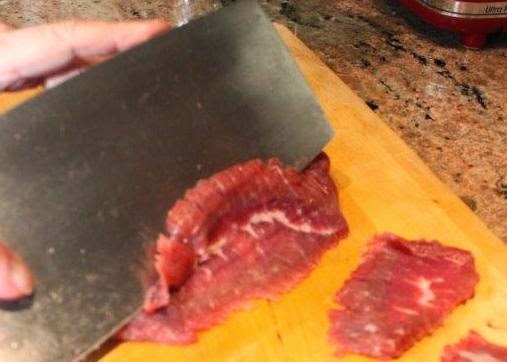One 4-to-4-1/2 lb. (1.75-to-2 kg) duckling, cleaned and plucked
1/4 c. (60 mL) orange juice
2 tbsp. (30 mL) granulated sugar
1/4 c. (60 mL) soy sauce
4 tsp. (20 mL) salt
1/4 c. (60 mL) dry sherry
1 tbsp. (15 mL) white vinegar
1/2 tsp. (2.5 mL) five-spice powder
1 slice fresh ginger root, peeled, about 3 x 1/2 in. (7.6 x 1.2 cm)
2-1/2 c. chicken stock (625 mL)
A few tbsp. cornstarch, as required, to thicken cooking liquid
Approximately 5 c. (1.25 L) peanut oil for deep-fat frying
1 large orange, unpeeled, halved and sliced, as garnish
Parsley bunches, as garnish (optional)
Read recipe carefully and have all ingredients assembled before you begin. In a large pot over high heat, plunge duckling into enough boiling water to cover. Boil 4 min. Drain.
 |
After boiling away fat, transfer duckling to clean pot. |
Transfer duckling to clean pot, adding all remaining ingredients except cornstarch, oil, and garnishes. Bring just to a boil before lowering heat.
Cover and simmer 45 min., turning duckling at least twice during cooking. Remove duckling from pot, draining and drying very thoroughly. Cooking liquid is the basis of the sauce for the duckling: Treat it with loving care. Over low heat, simmer liquid, uncovered, to reduce and thicken it.
 |
Simmer cooking liquid to reduce and thicken it. |
Over medium-high stove setting, heat oil in wok to a depth of about 4 in. (10 mL) (see Note). Carefully and securely lower duckling into oil (Ron uses a meat fork to do this).
 |
Carefully and securely lower duckling into oil. |
Oil will bubble around lower half of duckling and inside cavity.
 |
Oil will bubble inside and outside duckling. |
Also carefully and securely, turn duckling over to brown on all sides. This will take about 5 min.
 |
Turn duckling. |
 |
Turn again, until duckling is entirely browned. |
When duckling is crisp and golden, remove from hot oil.
 |
Remove from hot oil; drain well. |
Transfer wok or deep-fat fryer to a safe, stable spot away from pets and children’s reach. Let oil cool for later safe disposal or straining and recycling.
Return duckling to simmering sauce, turning several times to coat.
 |
Sauce will reduce and thicken. For further thickening, add cornstarch. |
If sauce appears too thin, decant about 1/4 c. (60 mL) to small bowl, cooling before stirring in cornstarch, as needed. Return cooled liquid to simmering sauce, blending in well until sauce thickens as desired.
Remove coated duckling from sauce. Transfer to chopping block, sectioning into small pieces with cleaver or heavy knife.
 |
Ron sections duckling into small pieces. |
Heap chopped duckling onto serving platter.
 |
Onto the platter goes the duckling! |
Pour hot sauce over duckling.
 |
Onto the duckling goes the sauce! |
Garnish with orange slices and parsley. Serve at once.
 |
Garnished duckling. |
This dish is extremely rich. Ron recommends you keep your servings small. Serves 8-to-10 as main course.
Note: Home-use deep-fat fryers are safer than oil-filled woks, but produce less satisfactory results. The maximum temperature of the oil in a deep-fat fryer is often lower than the temperature of the oil in a wok on the stove’s highest setting. The duckling may also not fit into a home-use deep-fat fryer. Use extreme caution when deep-fat frying. Allow enough room for the oil’s displacement as you lower the duckling into the wok or deep-fat fryer.


























